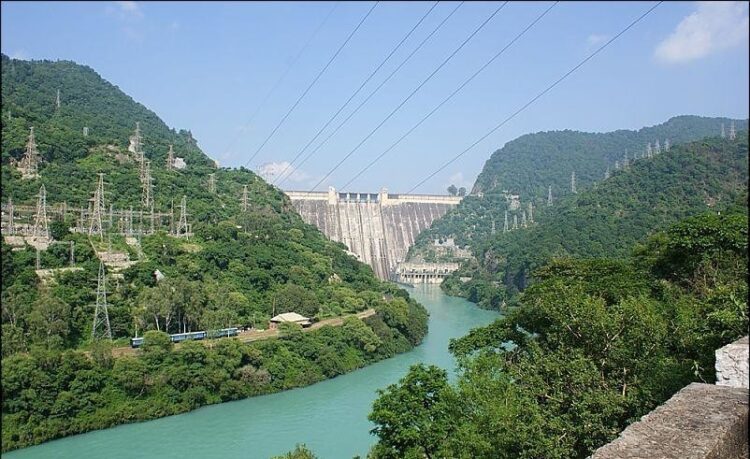KEY POINTS
- Turned dry lands fertile, boosted farming and food production.
- Supplied water and power, helping rural and industrial growth.
- Still vital, though facing environmental and modernization needs.
When India gained independence in 1947, the young nation faced massive challenges—partition trauma, food shortages, and a fragile economy. One of the most pressing needs was irrigation and power. The Bhakra-Nangal Project, which included a dam and a vast canal system, was envisioned not just as a means of water supply but as a symbol of modern India’s ability to rise through self-reliance and engineering excellence.
Among its various components, the Bhakra-Nangal Canal Project emerged as a vital part of this vision—bringing water to millions and turning barren lands into agricultural powerhouses.
The Geography and Purpose of the Project
The Sutlej River, originating from the Himalayas, flows through Himachal Pradesh and Punjab before entering Pakistan. Its waters had historically flowed uncontrolled, leading to seasonal floods and missed irrigation opportunities.
The Bhakra-Nangal Canal Project aimed to:
- Store water in the Bhakra Dam reservoir (Gobind Sagar),
- Divert it via canals for irrigation,
- Generate hydroelectric power, and
- Reduce flood risks.
- The system was planned to irrigate large areas of Punjab, Haryana, Rajasthan, and Himachal Pradesh—regions vulnerable to drought and food insecurity.
Construction Timeline and Major Components
The Bhakra-Nangal Project began taking shape in 1948, shortly after Independence. The major construction highlights include:
- Bhakra Dam: Construction started in 1955 and completed in 1963.
- Nangal Dam: Built downstream to regulate water flow.
- Canal Network: The canal system was inaugurated in 1954, even as dam construction continued.
While the dams were the engineering marvels, the canal system ensured the project’s ultimate goal—delivering water to the fields.
Role in Agricultural Transformation
Before this project, much of northwestern India relied on rain-fed agriculture, which was unreliable and limited in productivity.
After the canals became operational, vast tracts of arid land were irrigated year-round. This consistent water supply made it possible for farmers to:
- Cultivate multiple crops per year (double or triple cropping),
- Grow water-intensive crops like paddy and wheat,
- Adopt modern farming methods and high-yield seeds.
The canal project, therefore, directly enabled the Green Revolution in the 1960s and 70s, especially in Punjab and Haryana, turning them into India’s breadbasket.
Dual Benefits: Irrigation and Power
ALSO READ: “The End of the 1857 Rebellion: How a Crushed Uprising Sparked India’s Fight for Freedom”
While the canal system’s primary purpose was irrigation, it also helped support power infrastructure. Water released from the dam passes through hydroelectric turbines, which generate electricity before being diverted to the canals.
This hydropower:
- Powered industries in Punjab and Haryana,
- Provided electricity to growing urban centers,
- Reduced dependence on imported fuel.
- In essence, the same water irrigated crops and lit homes—demonstrating efficient resource use.
- The Canal Network: Scope and Reach
The Bhakra Main Canal originates from the Nangal Dam and runs over 164 kilometers through Punjab and Haryana, eventually branching into numerous distributaries.
Key features of the canal system include:
- Concrete-lined channels to reduce seepage,
- Cross-drainage works, including aqueducts and siphons,
- A network of branch canals like the Narwana and Sirsa branches.
The entire system irrigates over 40 lakh hectares of land annually—one of the largest in the world.
Political, Interstate, and Diplomatic Significance
The project took on geopolitical importance after Partition, when India lost control of several major irrigation canals to Pakistan. The Bhakra-Nangal Project restored water access and secured agricultural independence.
Water from the project had to be equitably distributed among Punjab, Haryana, and Rajasthan, requiring detailed interstate water-sharing agreements.
The Bhakra Beas Management Board (BBMB) was formed in 1966 to oversee operations, distribution, and maintenance across states.
Symbol of Nation-Building
India’s first Prime Minister Jawaharlal Nehru was deeply involved in the project and inaugurated its various stages. He famously referred to such infrastructure projects as the “temples of modern India.”
His vision saw engineering not just as construction but as:
- A source of national pride,
- A path to economic self-reliance,
- A unifier in a divided post-Partition landscape.
Technical and Logistical Challenges
Building such a massive canal system in newly independent India wasn’t easy. Engineers and workers faced:
- Difficult terrain and geological surprises,
- Shortages of materials and skilled labor,
- Floods and landslides during early years,
Need for advanced construction methods rarely used in India at that time.
International experts collaborated with Indian engineers, and over time, the nation built in-house expertise.
Socioeconomic Benefits
The Bhakra-Nangal Canal system created rural prosperity:
- Farmers had higher yields and incomes.
- Rural employment increased in agriculture and construction.
- The project spurred urban growth by providing water and power to towns.
Moreover, food grain production in India surged—helping the country move from being aid-dependent to self-sufficient by the 1970s.
Environmental and Sustainability Concerns
While the project brought massive benefits, it also raised environmental concerns:
- Waterlogging and soil salinity in some areas due to over-irrigation.
- Displacement of villages and communities due to dam submergence.
- Altered river ecology and disrupted aquatic life.
In recent years, efforts have been made to modernize canal operations using remote sensors, automation, and drip irrigation to reduce water loss and increase efficiency.
Maintenance and Modernization
After decades of service, parts of the canal network required repairs, desilting, and modernization. New technologies are being introduced:
- Lining upgrades to prevent seepage,
- Automated gates for better control,
- Use of satellite imaging to monitor flow and usage.
A Legacy That Flows On
The Bhakra-Nangal Canal Project was more than a civil engineering achievement—it was a nation-building mission. It turned deserts green, powered towns, and laid the foundation for India’s food security.
Even today, millions depend on its water, and its canals remain vital to India’s agricultural and economic success.
As India faces new challenges—climate change, groundwater depletion, and urban expansion—projects like Bhakra-Nangal remind us of the need for visionary, sustainable water management.

















Comments